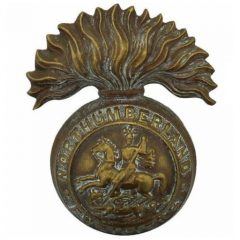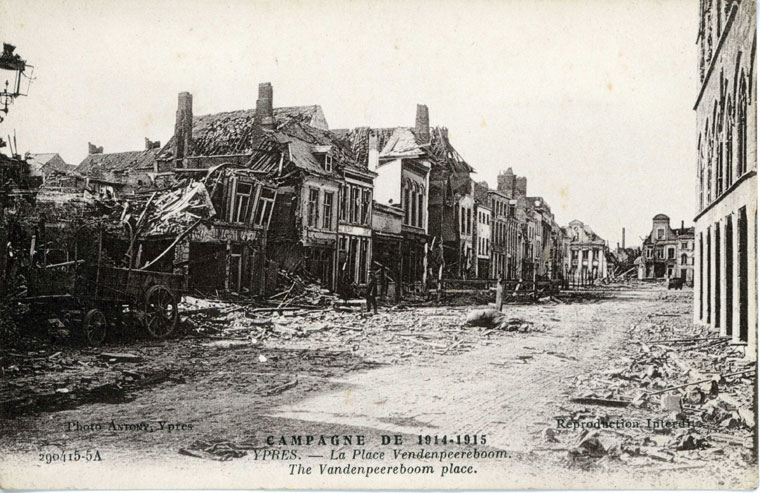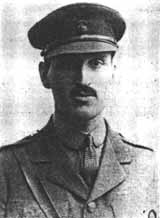26th March 1918
149th Bde in position. The order of battle from Estrees 1 to a point 1000 yards north of Assevillers 2 was 5th DLI, 7th DLI, 4th NF, 6th NF with the 5th NF held in reserve on the Assevillers-Fay road under the command of the GOC 149th Bde.
The morning of the 26th the enemy attacked again in strength, south-west and west from Nesle 3, no doubt with the intention of separating the French and British Armies and interfering with the detraining arrangements of the former by the capture of Montdidier 4.
To the left of the 149th Bde the 66th Divn were attacked and fell back under pressure leaving the left flank exposed. Two Coys from the 5th Bn counterattacked and restored the situation, but the 66th Bde continued to retire. With their northern flank exposed the 149th Bde retired to the Rosieres – Vauvillers line.
The 149th Bde, 5th and 7th Bn DLI retired under orders at 10am to the line Rosieres-Vauvillers. The 4th Bn withdrew through Fay and (2pm) Foucaucourt 5, to Herbevillers 6 and occupied posts around village of Vauvillers 7.
At 4pm the Bn made a successful counterattack at Framerville 8 and with the exception of the eastern end drove the enemy out of the village, but withdrew to Vauvillers posts at midnight.
27th March 1918
When dawn broke the 149th Bde occupied a line from Rosieres (excl) with men of the 5th DLI in support.
The enemy attacked the Rosieres line at about 8am. On the left and in the centre they were driven off, but on the right a Labour Coy fell back until a counter attack restored the situation.
Meanwhile the 50th Divn had practically been reduced to the 149th Bde which was holding four thousand yards of line between the 66th and 8th Divns. The retirements north of it had led to a warning order for a withdrawal being issued, but this had been misinterpreted by the Bns in the line, which at about 1pm began to fall back, abandoning Vauvillers near the junction with the 66th Divn. The position at Vauvillers was held until noon, at which time they withdrew because the troops on both flanks had retired.
At 12 noon an attack developed along the whole of the front line held by the 8th, 50th, 66th and 39th Divns. The 66th Divn retired at 1pm, followed by the 5th Bn NF at 2pm.
The 8th Divn, which had at once formed a defensive flank, attacked on the right while on the left the 7th (Pioneer) Bn DLI and 22nd Entrenching Bn, with some 66th Divn reserves, went forward.
About 3pm, these troops, well supported by artillery, were under way, and struck the enemy, who was advancing in eight or ten waves. They drove the foremost waves back and re-established the 50th Divn line, recapturing Vauvilliers.
At 3pm Brigadier-General Riddell lead the Bde in the counterattack by all available troops, including details from Bde HQ, which drove the enemy back from Harbonniers 9 over our old line except that we did not retake Vauvillers although the 4th Bn held the western half of the village. Very heavy losses were inflicted on the enemy and two machine guns and 50 prisoners taken.
The success was only temporary, for the Germans attacked once more and, when the defenders ammunition began to run short, broke in south of the village and enfiladed the line, causing another retirement.
7pm the line withdrew to the light railway between Rosieres station and crossroads half mile east.
They were halted on the light railway that ran diagonally behind the position. The enemy was already taking advantage of the gap that had been left, consequently a counterattack was organised from both flanks.
So by the evening the counter-attacking troops and the 50th Divn were back again on the light railway east of Harbonnieres.
At 8pm the enemy made another determined attack, advancing in no less than twelve waves, but was repulsed again.
That night (27th-28th) the allied line, south of the Somme, ran from Mesnil-St-Georges (west of Montdidier) to Hamel via Boussicourt, Arvillers, Warvillers, Rosieres and Harbonnieres.
More than 17 fusiliers from the 4th Bn were killed in action or died of wounds during the actions at Rosieres. For information on 4th Bn burial and memorial sites for casualties sustained at Rosieres, select the link.
Bibliography
[zotpress items="HUXKQ9EA" style="harvard1"]
[zotpress items="WPX27IS4" style="harvard1"]
[zotpress items="5MC7CZF6" style="harvard1"]
[zotpress items="NH3TRT6B" style="harvard1"]
[zotpress items="4R6FADJ9" style="harvard1"]
Rosieres - Military Units
8th Division - Consisted of the 23rd, 24th and 25th Bdes.
The 23rd Bde Comprised of the 2nd Bn - Devonshire Regt, 2nd Bn - West Yorkshire Regt and 2nd Bn Middlesex Regt.
The 24th Bde Comprised of the 1st Bn - Worcestershire Regt, 1st Bn - Sherwood Foresters and 2nd Bn - Northamptonshire Regt.
The 25th Bde 2nd Bn - East Lancashire Regt, 2nd Bn - Royal Berkshire Regt and 2nd Bn Rifle Brigade
22nd Entrenching Bn
39th Division - Consisted of the 116th, 117th and 118th Bdes.
The 116th Bde - Comprised of the 11th & 13th Bns - Royal Sussex Regt and 1/1st Bn - Hertfordshire Regt
The 117th Bde - Comprised of the 16th Bn - Sherwood Foresters, 17th Bn - King’s Royal Rifle Corps and 16th Bn - Rifle Brigade.
The 118th Bde - Comprised of the 1/6th Bn - Cheshire Regt, 4/5th Bn - Black Watch and 1st Bn - Cambridgeshire Regt.
50th (Northumbrian) Division Consisted of the 149th (Northumberland) Bde, 150th (York & Durham) Bde and 151st (Durham Light Infantry (DLI)) Bde
The 149th (Northumberland) Bde - Comprised of the 1/4th, 1/5th & 1/6th Bns - Northumberland Fusiliers.
The 150th (York & Durham) Bde - Comprised of 1/4th Bn - East Yorkshire Regt, 1/4th & 1/5th Bns - Green Howards.
The 151st (Durham Light Infantry) Bde - - 1/5th, 1/6th and 8th Bn - DLI
66th Division - Consisted of the 197th, 198th and 199th Bdes.
The 197th Bde - Comprised of the 1/6th, 2/7th & 2/8th Bns - Lancashire Fusiliers.
The 198th Bde - Comprised of the 1/4th & 2/5th Bns - East Lancashire Regt and 1/9th Bn - Manchester Regt.
The 199th Bde - Comprised of the 2/5th, 2/6th & 2/7th Bns - Manchester Regt.
If would like to read the full story of the 4th NF in World War 1, then please select here


